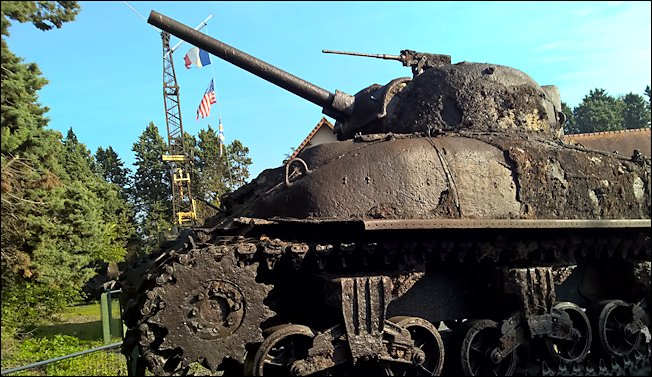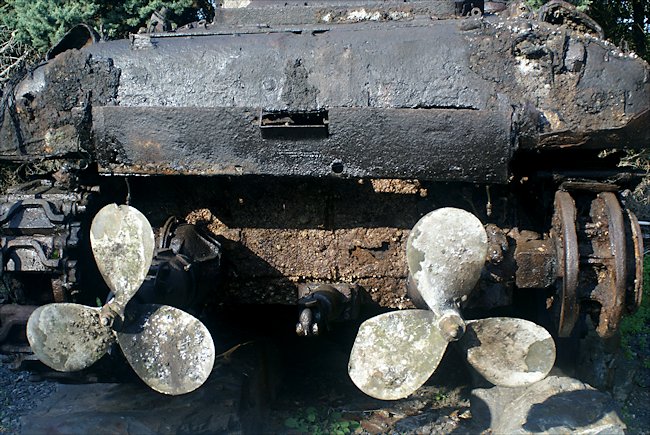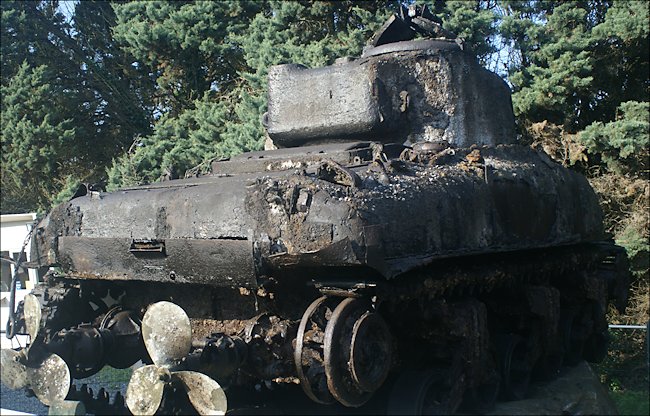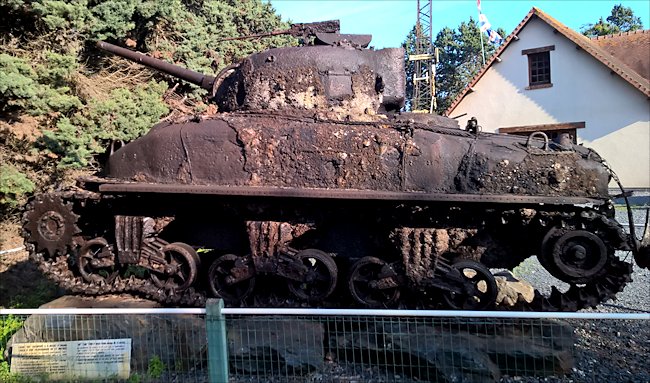Port-en-Besin M4A1 Sherman DD Tank
The two under water wrecked Sherman Duplex Drive tanks in the Musee des Epaves sous Marine du Debarquement are testament to the fact that not all the DD tanks deployed on D-Day 6th June 1944 made it to the Normandy beaches.

M4A1 Sherman Duplex Drive tank underwater wreck preserved at the Musee des Epaves sous Marine du Debarquement
Location
This is the D-Day wrecks museum. It is situated on the D6 road from Bayeux to the charming Normandy costal village of Port-en-Bessin-Huppain. It is on the right as you pass the sign for the Chateaux La Cheneviere restaurant.
The complex grounds are screened by a wall of tall evergreen trees. Sticking above the tree tops is a crane and normally three flags; the French tricolour, British Union Jack and American Stars and stripes. Slow your car down as you pass the Chateaux as the museum entrance is very quickly upon you.
The Museum is open every day between 1st June to the 30th September 10am to 1pm closed for lunch and then open again 2pm to 7pm. In May it is only open at the weekend. From 1st October to the end of April it is closed.
Specification
The Sherman M4A1 tank required a crew of 5: Commander, driver, gunner, loader, co-driver/hull machine gunner. It was powered by a Continental R975 C1 9 cylinder radial petrol engine that produced 400 hp. It had a top road speed of a around 30 mph (48 km/h) and an operational range of 120 miles (193 km) before the tank crew had to refuel.
Its main gun was a 75mm M3 L/40 gun that fired high explosive HE artillery shells as well as armour piercing AP rounds. This gun could not penetrate the front armour of a German Panther or Tiger tank. The Sherman also had two .30-60 Browning M1919A4 machine guns, one in a ball mount in the hull and another coaxial next to the main gun in the turret. It had a cast hull and turret. Armour thickness ranged from 25mm - 76mm but unlike some of the British tanks designs that used vertical armour plates the Sherman tanks armour was sloped at the front giving the tank added protection without the negative effects of extra weight.

Twin propellers were fitted to the rear of the Sherman DD tanks so they could make their own way to the Normandy Beaches.
This DD tank's history
This M4A1 DD Sherman tank has a plaque nearby that states 'DD tank sunk 4 miles from Omaha by 27 meters (in 88 feet of water) on morning june 6 1944 6.30am. Thirty two amphibious DD tanks of the 741th Tank Battalion are launched 4 miles from Omaha Beach 27 of them sink, unable to fight the heavy seas. Two reach the beaches due to the skill of their drivers. Three others are beached by their LCT landing craft whose ramped had jamed.' It was recovered from offshore in July 1980. It is missing its flotation screen and half its right-hand track.
Deployment in Normandy 1944
The Sherman Duplex Drive tanks swam very well in calm waters but on D-Day the North Atlantic Ocean was rough. The sea came over the top of the DD tanks canvas and flooded the inside. Many of the crews died in the tanks as the collapsed soaked canvas and the weight of the water above the tank hatches meant that the men could not get out. They drowned.
Records show that 294 Sherman DD tanks were embarked on tank landing craft on D-Day. Only 122 were launched. The launch rate was less than 42%. Of those tanks that launched 39 sunk, most of those on the approach to Omaha Beach. 83 successfully landed on the beach and fought mainly on Utah, Sword and Juno beaches. The other DD tanks were landed directly on the beach by tank landing craft.

When the DD tanks reached shore the propellers were removed. This tank never made it to the Normandy beach
Sword beach DD tanks
The 13/18 Hussars were the equipped with Sherman DD tanks. They were part of the 3rd British Division and were tasked with attacking Sword Beach. 38 tanks were embarked on landing craft. 32 were launched at a distance of 5,000 yards away from the beach. 3 are recorded as sunk and 29 touched down on the beach and fought. They landed at around 7.45am, 5-10 minutes aster the mine clearing flail tanks and Churchill AVRE tanks. 5 DD tanks were discharged onto Sword beach by landing craft. LCT 467 landed 5 on the beach due to screen damage at about 8.25am. Landing craft LCT 465 had its ramp damaged and returned to England with one DD tank trapped on board.
Juno beach DD tanks
The 6th Canadian Armoured Regiment (1st Canadian Hussars) were the equipped with Sherman DD tanks. They were part of the 3rd Canadian Division and were tasked with attacking Juno Beach. 40 tanks were embarked on landing craft. 30 were launched at a distance of 1,000 yards away from the beach. 5 are recorded as sunk and 25 touched down on the beach and fought.
They landed on the beach between 7.40am and 7.59am. 10 DD tanks were landed directly on the beach by landing craft. The ramp on LCT 413 was damaged after one DD tank had launched. It was further damaged by a mine as it neared Juno Beach. It was only able to discharge 2 DD tanks into the surf. An accompanying LCT discharged 5 DD tanks at the same time. most of these tanks were swamped by large waves after landing. Due to various mishaps 3 DD tanks were not landed on Juno Beach until the afternoon.
The 10th Canadian Armoured Regiment (Fort Garry Horse) were the equipped with Sherman DD tanks. They were part of the 3rd Canadian Division and also tasked with attacking Juno Beach. 40 tanks were embarked on landing craft. None were launched. They were all landed on the beach by landing craft. The 20 tanks of C squadron where discharged at 8.05am and the 20 tanks of B squadron landed at 8.25am.

A metal boat shaped shelf was welded around the hull of the Sherman DD Tank onto which was attached the Canvas Screen
Gold beach DD tanks
The British 4/7 Royal Dragoon Guards were the equipped with Sherman DD tanks. They were part of the 50th Division and were tasked with attacking Gold Beach. 40 tanks were embarked on landing craft. None were launched. All the DD tanks landed on a dry beach at 7.20am 5-10 minutes before the AVRE tanks and the infantry assault units.
The British Nottinghamshire Yeomanry (Sherwood Rangers) were the equipped with Sherman DD tanks. They were part of the 50th Division and also tasked with attacking Gold Beach. 40 tanks were embarked on landing craft. None were launched. They all waded in through the surf at 7.58am, about 40 minutes after the leading elements. They provided high explosive HE shell support from the surf. Waves were high and 8 of the tanks were swamped. 4 were knocked out.
Omaha beach DD tanks
The US 741st Tank Battalion were the equipped with Sherman DD tanks. They were part of the 1st US Infantry Division and were tasked with attacking Omaha Beach. 32 tanks were embarked on landing craft. 32 were launched at a distance of 5,000 yards away from the beach. 27 are recorded as sunk and 2 touched down on the beach and fought. They landed on Omaha Beach at 6.30am. 3 DD tanks were discharged onto the beach by landing craft LCT 600 at about 6.40am. Their canvas screens had been damaged by an explosion offshore which was why they had not been launched.
The US 743rd Tank Battalion were the equipped with Sherman DD tanks. They were part of the 29th US Infantry Division and also tasked with attacking Omaha Beach. 32 tanks were embarked on landing craft. None were launched. They all landed on Omaha Beach under fire at 6.40am and began engaging German beach defence strongpoints while moving to and fro in the surf. 23 of this batch of DD tanks were still operational at the end of the day.
Utah beach DD tanks
The US 70th Tank Battalion were the equipped with Sherman DD tanks. They were part of the 4th US Infantry Division and were tasked with attacking Utah Beach. 32 tanks were embarked on landing craft. 28 were launched at a distance of 3,000 yards away from the beach. 1 is recorded as sunk and 27 touched down on the beach and fought. They landed on the beach about 6.50am, 20 minutes after the leading assault elements had landed at 6.30am. 4 DD tanks were lost at sea when landing craft LCT 593 hit a mine. The launching of the Utah beach DD tanks closer to the beach saved the crews from the same fate as the Omaha beach DD tanks.
Where can I find other preserved DD Tanks?
- Valentine MkVIII DD - John Pearson Collection England
- Sherman DD M4A2(75) - Bovington Tank Museum, England
- Sherman DD M4A1(75) – Exercise Tiger Memorial, Torcross, England
- Sherman DD M4A1(76) – French Tank Museum, Saumur, France
- Sherman DD M4A1(75) – Small hatch, D-Day Underwater Wrecks Museum, Commes, France
- Sherman DD M4A1(75) – Large hatch, D-Day Underwater Wrecks Museum, Commes, France
- Sherman DD M4A4(75) – Juno Beach, Courseulles-sur-Mer, France
- Sherman DD M4A4(75) – Rixheim, France
- Sherman DD M4A1(75) – Small hatch, Piana delle Orme Museum, Italy
- Sherman DD M4A2(75) - Armoured Corps Museum, Ahmednagar, Maharashtra, India
- Sherman DD M4A2(75) - Jaisalmer War Museum, Jaisalmer, India
- Sherman DD M4A2(75) - Mandoli (near Belgaum), Karnataka, India
- Sherman DD M4A2(76) HVSS - U.S. Army Center for Military History Storage Facility Anniston, AL, USA
D-Day 1944 books

